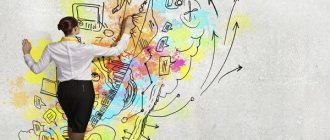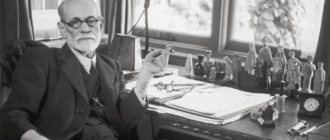Oral phase
The infant, completely dependent on the mother for pleasure, is in the oral phase (0-12 months) and in the biological stage, characterized by rapid growth. The oral phase of development is characterized by the fact that the main source of pleasure and potential frustration is associated with feeding. In the psychology of a child, one desire dominates - to absorb food. The leading erogenous area of this stage is the mouth as an instrument of feeding, sucking and initial examination of objects.
At the age of two to three months, the child can already observe the difference between the expression of pleasure and displeasure. At the oral stage of libido fixation in a person, according to 3. Freud, some personality traits are formed: gluttony, greed, demandingness, dissatisfaction with everything offered. Already at the oral stage, according to his ideas, people are divided into optimists and pessimists.
15.6. Behavioral theory of personality
The behavioral theory of personality also has another name - “scientific”, since the main thesis of this theory states: our personality is a product of learning.There are two directions in the behavioral theory of personality - reflexive and social. The reflex direction is represented by the works of famous American behaviorists J. Watson and B. Skinner. The founders of the social direction are American researchers A. Bandura and J. Rotter.
The main source of personality development, according to both directions, is the environment in the broadest sense of the word. Personality has nothing of genetic or psychological inheritance. Personality is a product of learning, and its properties are generalized behavioral reflexes and social skills. From the point of view of behaviorists, any type of personality can be formed to order - a worker or a bandit, a poet or a merchant. For example, Watson did not make any distinction between the development of emotional reactions in humans and the salivary reflex in a dog, believing that all emotional properties of a person (fear, anxiety, joy, anger, etc.) are the result of the development of classical conditioned reflexes. Skinner argued that personality is a set of social skills formed as a result of operant conditioning. Operant Skinner called any change in the environment as a result of any motor act. A person tends to perform those operants that are followed by reinforcement, and avoids those that are followed by punishment. Thus, as a result of a certain system of reinforcements and punishments, a person acquires new social skills and, accordingly, new personality traits - kindness or honesty, aggressiveness or altruism (Godefroy J., 1992; Skinner B.F., 1978).
According to representatives of the second direction, an important role in the development of personality is played not so much by external as by internal factors, for example, expectation, goal, significance, etc. Bandura called human behavior determined by internal factors self-regulation. The main task of self-regulation is to ensure self-efficacy, that is, to perform only those forms of behavior that a person can implement, based on internal factors at any given moment. Internal factors act according to their own internal laws, although they arose from past experience as a result of learning through imitation (Kjell A., Ziegler D., 1997). Rotter is an even greater cognitive scientist than Bandura. To explain human behavior, he introduces the special concept of “behavioral potential,” which means a measure of the probability of what behavior a person will perform in a given situation. The potential of behavior consists of two components: the subjective significance of reinforcement for a given behavior (how valuable and significant the upcoming reinforcement is for a person) and the availability of this reinforcement (how much the upcoming reinforcement can be implemented in a given situation).
Behaviorists believe that personality is formed and develops throughout life through socialization, upbringing and learning. However, they view the early years of a person's life as more important. The foundation of any knowledge and abilities, including creative and spiritual ones, in their opinion, is laid in childhood. In personality, rational and irrational processes are represented equally. Their opposition makes no sense. It all depends on the type and complexity of the behavior. In some cases, a person can be clearly aware of his actions and behavior, in others - not.
According to behavioral theory, a person is almost completely deprived of free will. Our behavior is determined by external circumstances. We often behave like puppets and are not aware of the consequences of our behavior, since the social skills we have learned and the reflexes from long-term use have long been automated. The inner world of a person is objective. Everything about him is from the environment. Personality is completely objectified in behavioral manifestations. There is no “façade”. Our behavior is our personality. Behavioral traits of personality are amenable to operationalization and objective measurement.
The elements of personality in the behaviorist theory of personality are reflexes or social skills. It is postulated that the list of social skills (i.e. properties, characteristics, personality traits) inherent in a particular person is determined by his social experience (learning). Personality properties and the requirements of a person’s social environment coincide. If you were raised in a kind, calm family and were encouraged to be kind and calm, then you will have the characteristics of a kind and calm person. And if you are sad and sad or have increased vulnerability, then it is also not your fault; you are a product of society and upbringing.
It is important to emphasize that the problem of reinforcement among behaviorists is not limited to food. Representatives of this school of thought argue that humans have their own ecologically valid hierarchy of reinforcements. For a child, the most powerful reinforcement, after food, is active reinforcement (watch TV, video), then manipulative reinforcement (play, draw), then possessive reinforcement .
- own) reinforcement (sit on dad's chair, put on mom's skirt) and, finally, social reinforcement (praise, hug, encourage, etc.).
If, within the framework of the reflex direction of behavioral theory, the existence of certain personality blocks is actually denied, then representatives of the social-scientific direction consider the identification of such blocks to be quite possible.
In the behavioral model, there are three main conceptual blocks of personality. The main block is self-efficacy, which is a kind of cognitive construct “I can - I can’t.” A. Bandura defined this structure as a belief, belief, or expectation of receiving future reinforcement. This block determines the success of performing a certain behavior, or the success of mastering new social skills. If a person makes a decision: “I can,” then he begins to perform a certain action, but if a person makes a verdict: “I can’t,” then he refuses to perform this action or to learn it. For example, if you decide that you cannot learn Chinese, then no force will force you to do it. And if you decide that you can do it, then sooner or later you will learn it.
According to Bandura, there are four main conditions that determine the development of a person's confidence in what he can and cannot do:
1) past experience (knowledge, skills); for example, if I could before, then apparently I can now;
2) self-instruction; for example, “I can do it!”;
3) increased emotional mood (alcohol, music, love);
4) (the most important condition) observation, modeling, imitation of the behavior of other people (observing real life, watching movies, reading books, etc.); for example, “If others can do it, then I can too!”
J. Rotter identifies two main internal blocks of personality - subjective significance (a structure that evaluates upcoming reinforcement) and availability (a structure associated with the expectation of receiving reinforcement based on past experience). These blocks do not function independently, but form a more general block called behavioral potential, or the cognitive motivation block (Kjell A., Ziegler D., 1997).
The holistic properties of a personality are manifested in the unity of action of blocks of subjective significance and accessibility. People who do not see a connection (or see a weak connection) between their behavior (their efforts, their actions) and their results (reinforcements), according to Rotter, have an external, or external “locus of control.” “Externals” are people who do not control the situation and hope for chance in their lives. People who see a clear connection between their behavior (their efforts, their actions) and the results of their behavior have an internal, or internal, “locus of control.” “Internals” are people who manage the situation, control it, it is available to them.
Thus, within the framework of this approach, personality is a system of social skills and conditioned reflexes, on the one hand, and a system of internal factors: self-efficacy, subjective significance and accessibility, on the other. According to the behavioral theory of personality, personality structure is a complexly organized hierarchy of reflexes or social skills, in which the leading role is played by the internal blocks of self-efficacy, subjective significance and accessibility.
Answer to the test question “Why are some people more aggressive than others?” within the framework of this theory it is formulated as follows: because in the process of upbringing these people were rewarded for aggressive behavior, their environment consisted of aggressive people and aggressive behavior itself is subjectively significant and accessible for them.
Anal phase
The oral period is followed by the anal period (from 12-18 months to 3 years), during which the child first learns to control his bodily functions.
Here the child encounters many prohibitions for the first time, so the outside world appears before him as a barrier that he must overcome, and development takes on a conflicting character. Social coercion, punishment from parents, fear of losing their love force the child to mentally imagine and internalize certain prohibitions. In this way, the child’s Super-Ego begins to form as part of his Ego, where the authorities, the influence of parents and other adults are mainly based, who play a very important role as educators and socializers of the child.
Character traits that are formed at the anal stage, according to psychoanalysts, are neatness, neatness, and punctuality.
The essence of personality in behaviorism
Personality in the theory of behaviorism is understood, first of all, as a reacting, acting, learning being. A person here is programmed for certain reactions, actions, behavior. If you change incentives and reinforcements, you can give a person a program for the required behavior.
Note 1
Human personality, as a set of behavioral reactions that are characteristic of a given individual, represents the basis of personality theories included in the behavioral direction.
Finished works on a similar topic
Course work General characteristics of personality theories related to the behavioral direction 490 ₽ Abstract General characteristics of personality theories related to the behavioral direction 220 ₽ Test paper General characteristics of personality theories related to the behavioral direction 220 ₽
Receive completed work or specialist advice on your educational project Find out the cost
An appropriate behavioral response may occur to a specific stimulus or situation. The stimulus-response formula is the leading concept of behaviorism. Thorndike's Law of Effect states that the stimulus-response relationship is strengthened by reinforcement.
According to personality theory, reinforcement can be positive (e.g., praise) or negative (e.g., punishment, pain, failure). Human behavior is typically driven by the expectation of positive reinforcement, although sometimes the desire to eliminate negative reinforcement may prevail.
Latent period
After five years, a long period of latent childhood sexuality begins (5-12 years), when the former curiosity about sexual manifestations gives way to curiosity about the entire world around us.
The child goes through many developmental changes during these years, and sexual latency is relative rather than absolute. To some extent, the child has renounced, allowed, or suppressed the libidinal desires of the Oedipal phase due to the development of the ego and superego. Now parental expectations and prohibitions are perceived by him more consistently, as demands directed to his consciousness, and the painful effects of shame and guilt limit the search for libidinal satisfaction
Behavioral theories of personality
With the help of the humanistic theory of personality, a study is made of healthy, harmonious individuals who have reached the pinnacle of personal development, the pinnacle of “self-actualization.” Such people make up only 1–4% of the total population, while the rest may be at different stages and stages of development.
An active position in relation to reality, research and analysis of reality, and not running away from it, the ability to see the events of one’s own life as they are, without using psychological defense, understanding that problems are hidden behind negative emotions - all this allows a person to understand yourself, the meaning of life, achieve inner harmony and become a self-actualizing person.
Are you an expert in this subject area? We invite you to become the author of the Directory Working Conditions
Behavioral theories of personality are a branch of theoretical and experimental psychology. It is based on the S-R (stimulus-response) scheme. The theory was developed within the framework of American psychology and was based on the ideas of I. P. Pavlov, J. B. Watson, E. L. Thorndike. Representatives of this direction were E. K. Tolman, E. R. Guthrie, K. L. Hull, Skinner, N. E. Miller, J. Dollard.
The concept under consideration is distinguished by special attention to the design and implementation of the experimental procedure, scientific accuracy and control of results. The methodological arsenal of the behavioral theory of personality includes the procedure for creating and developing a connection between the impact on the individual and certain behavior.
With the help of the behavioral theory of personality, the conditions for the formation, consolidation, and disappearance of the following phenomena are studied:
- Habits
- Skills,
- Behavioral patterns.
Personality here is equated to intermediate elements located between stimulus and response. Without denying innate factors, behaviorists study observable behavior and environmental factors that determine behavior.
The formation of personality must be considered as the result of learning: the reinforcement of certain types of behavior and the exclusion of others. Main types of learning:
- Classical teaching of I. P. Pavlov,
- Skinner's operant conditioning
- The extinction of I. P. Pavlov,
- Imitation of Bandura.
The study of the foundations and driving forces of personality development can act as an analysis of the physiological mechanisms of drives. It is customary to distinguish the following types of motivations: primary (physiological) and secondary (psychological). Personality development occurs through differentiation, the emergence of a hierarchy of motivations, and the emergence of new patterns of behavior based on reinforcement.
As for secondary motives, over time they can gradually become leading ones. In this process, the reinforcement system becomes more complex. Primary reinforcements gradually begin to lose their significance, reactions are differentiated, they are generalized on the basis of speech, and internal organization is acquired.
Who developed this theory?
The theory of social learning, the main ideas of which were voiced by scientists at the beginning of the last century, was created in the American and Canadian works of authors such as A. Bandura, B. Skinner, R. Sears.
However, even these psychologists, being like-minded people, viewed the main provisions of the theory they created differently.
Bandura studied this theory from an experimental approach. Through numerous experiments, the author revealed a direct relationship between examples of various behaviors and children’s imitation of them.
Sears consistently proved that a child during his life goes through three phases of imitation of adults, the first of which is unconscious, and the second two are conscious.
Skinner created the theory of so-called reinforcement. He believed that the child’s assimilation of a new behavior model occurs precisely thanks to such reinforcement.
Thus, the question of which scientist developed social learning theory cannot be answered unambiguously. This was done in the works of a whole group of American and Canadian scientists. Later, this theory became popular in European countries.
Works of psychologist R. Sears
The theory of social learning was also embodied in the works of psychologist R. Sears. The scientist proposed the concept of dyadic analysis of personal development. The psychologist said that a child’s personality is formed as a result of dyadic relationships. These are the relationships between a mother and her child, a daughter and her mother, a son and her father, a teacher and a student, etc.
At the same time, the scientist believed that a child in his development goes through three stages of imitation:
- rudimentary imitation (occurs at an early age on an unconscious level);
— primary imitation (the beginning of the process of socialization within the family);
- secondary motivational imitation (begins from the moment the child enters school).
The scientist considered the most important of these phases to be the second, which was associated with family education.
The essence of Bandura's theory
The author of the theory of social learning, Bandura, believed that a person’s personality should be considered in the interaction of his behavior, social environment and cognitive sphere. In his opinion, it is situational factors and predisposition factors that determine human behavior. The scientist believed that people themselves can consciously change a lot in their behavior, but for this their personal understanding of the essence of the events taking place and their desire are very important.
It was this scientist who came up with the idea that people are both a product of their own behavior and the creators of their own social environment and, accordingly, its behavior.
Unlike Skinner, Bandura did not point out that everything depends on external reinforcement of human behavior. After all, people can not only copy someone’s behavior by observing him, but read about such manifestations in books or see them in films, etc.
According to A. Bandura, the central concept in the theory of social learning is learning, conscious or unconscious, which every person born on earth adopts from his immediate environment.
At the same time, the scientist pointed out that people's behavior is regulated mainly by the fact that they understand the consequences of their actions. Even a criminal who goes to rob a bank understands that the consequence of his actions may be a long prison sentence, but he goes for it, hoping that he will avoid punishment and receive a large win, which is expressed in a certain amount of money. Thus, the mental processes of the human personality give people, unlike animals, the ability to foresee their actions.
Helpful Chart: The Evolution of Social Learning Theory Over the Last Century
Thus, having examined the works of a number of scientists, we can conclude that this theory, having emerged at the beginning of the last century, went through a long period of its formation, enriched in the works of many scientists.
The term itself arose in 1969 in the works of the Canadian Albert Bandura, but the theory itself received its holistic design both in the writings of the scientist himself and his ideological followers.
The evolution of social learning theory, also called social cognitive theory, suggests that the most important thing in a person’s life is the example of behavior of the people around him.
Another key term of this concept was the phenomenon of self-regulation. A person can change his behavior at will. Moreover, he can form an image of the desired future in his mind and do everything to make his dream come true. People who are deprived of a goal in life, who have a vague idea of their future (these are called “go with the flow”), lose a lot compared to those people who have decided how they want to see themselves in years and decades. Another problem that supporters of this concept also address in their works: what to do if the goal cannot be realized?
Indeed, in this case, a person experiences burning disappointment in life, which can lead him to depression and suicidal thoughts.







